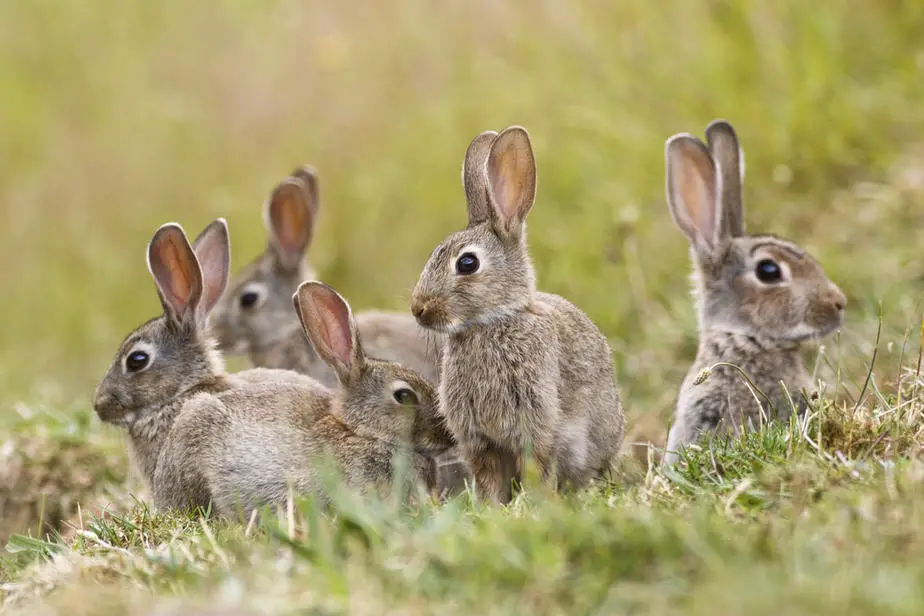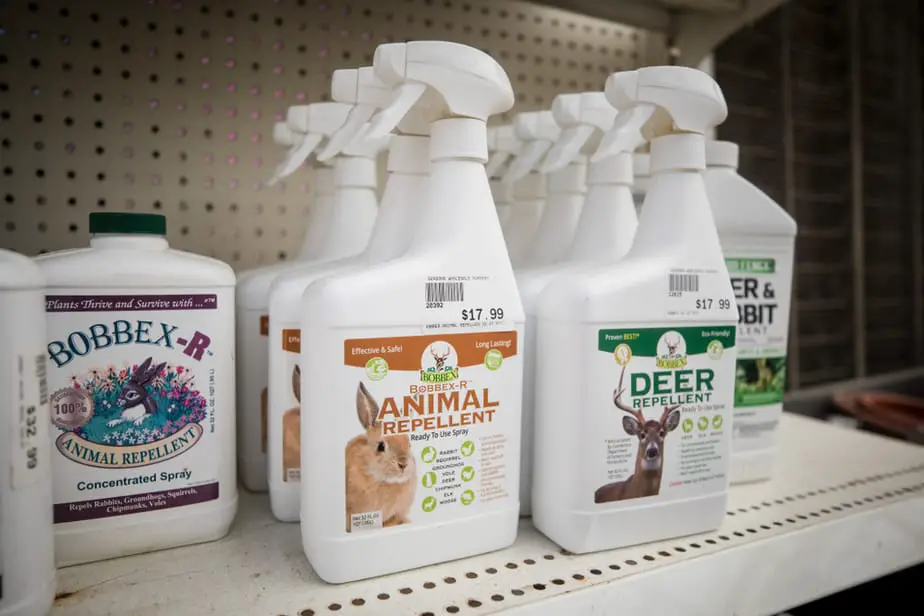Someone who tills the soil knows that a rabbit can be much more than a cute visitor to their carrot patch. With its voracious appetite for a wide variety of fresh vegetation – including annuals, perennials, woody plants, and berries – this long-eared animal has a ridiculously long menu of favorite meals.

What’s more, we all know they have extremely high reproductive potential. Each can easily have three litters per year with six or more kits per litter. Where there is one rabbit there’s likely to be several more hiding away. It’s no wonder a colony of hungry rabbits can decimate your garden overnight. That’s why you have to take timely measures to repel plant-eating rabbits and prevent a total garden infestation.
Table of Contents
Identifying Rabbits in Your Garden

Before you decide to take steps to repel rabbits, you should first look for the signs that you are indeed dealing with a rabbit infestation. The level of damage to plant stock depends on the type of rabbit attacking it. The eastern cottontail is probably the most destructive. They are easy to identify – Brown with the usual long ears and a very definite cotton ball tail. They are 15-19 inches long fully-grown and 2-4 pounds in weight depending on the season. They prefer to stay close to cover and use brushy fence-rows as runs around their territory, stay hidden in brush piles during the day and generally stick to field edges.
Their fondness for veggies, flowers, bulbs, and bark means clipped cosmos and pruned peppers. They will devour anything they like. Being diggers, although not great warren builders like their European cousins, they are more than capable of eating a plant from leaf tip to root. The best time to catch them in the act is very early in the morning and dusk.
How to Repel Plant-Eating Rabbits

Once you’ve confirmed you’re up against plant-eating rabbits, it is time to try some long tried-and-tested methods. Although rabbits are clever at getting what they want generally, people try one of three strategies for protecting their plants. They use repellants, invest in targeted coverage and build fencing.
Let’s take a look at each option individually:
Targeted Coverage
If you have peas and beans or another plant or crop that rabbits simply adore, you can consider targeting just that area. You can make use of garden fabric to wrap the plants – it works great to help protect an area of salad greens or newly planted broccoli. Take special care when anchoring the fabric since rabbits are persistent when they spot a tasty target.
Mesh fencing may also help in this case. You can easily use poultry mesh to cover susceptible plants and prevent rabbits from gaining access to the area. The same mesh fencing can also be used to create a protective tunnel if you’re trying to protect an entire row. But beware, rabbits know about fences and will stubbornly worry away at any weak points.
Repellents
Rabbits use smell to keep an eye out for predators. When your goal is to keep rabbits from entering your backyard, going for repellents that have the smell of rabbit eaters is probably going to be your best bet.
Garlic odor repellents work well to repel rabbits, provided the rabbits haven’t already developed a liking for it or there’s nothing more appealing on the menu. Nevertheless, try different repellents to keep your rabbits away for at least enough time for young plants to become established and grow ahead of the rabbits. You’ll need to reapplying them every few days after it rains.
While you can find many repellents on the market, it is also possible to make them from what you find in your kitchen. Homemade repellents can go a long way towards keeping rabbits away from your garden. Here’s how you can make a repellent on your own:
- Garlic and Onions: Get 3 chili peppers, one large bulb of garlic and at least three large onions and chop them finely in a blender. Put the mixture in a container and cover it with water and leave to stand and infuse. When you are ready to spray, strain the mix for the water and a little more if necessary.
- Tabasco Sauce and Cayenne Pepper: Mixing tobacco sauce with cayenne pepper along with water and dishwashing soap is a simple homemade repellent that works surprisingly well. Adding a splash of Elmer’s glue gives it an extra kick rabbits don’t like. Spray it liberally on your plants and around your garden.
- Egg and Garlic Mixture: Rabbits have an impressive sense of smell so anything pungent is too much to cope with. That’s why using a mixture of milk, egg, tobacco sauce, garlic, and liquid dishwashing soap repels rabbits so well.
- Linseed Oil and Detergent: Mix detergent and water into twice the amount of raw linseed oil. Both pungent and sticky.
Fencing
Fencing your garden will keep rabbits from entering the forbidden area. Fencing your entire garden may be your only option for keeping rabbits at bay. Since rabbits can jump and even climb a little, the fence needs to be at least 3ft in height, more if your foe is a jackrabbit. To prevent burrowing, the fencing needs to be embedded at least a foot into the ground and the meshing turned away from your garden. Similarly, you can invest in self-supporting pop-up nets that are anchored to the ground to keep rabbits out.
Additional Considerations
Along with keeping rabbits away by protecting a particular area, fencing the entire garden or using repellents, there are also other considerations. For instance:
- Use Specific Plants to Repel Rabbits: Just like spraying your most important crops with repellents, you can also use natural barriers of plants rabbits don’t like to stop them reaching something they love. Some good options include daffodils, sage, mint, black-eyed Susan, asparagus, rosemary, oak, yarrow, lavender, onions, tomatoes, and thyme.
- Use their Favorites to Protect Other Crops: Sometimes, you have to use strange tactics and one is planting something they really like to keep them from invading into areas with planting more important to you. It’s something to try when other things aren’t working. Giving over a small patch of alfalfa or clover might mean you can find a way to coexist and still save your beans and lettuce.
- Try to Scare Them Away: So many people have used pretend owls, aluminum pie pans and many other things to scare rabbits off. These methods do work but only for a short time. Rabbits can quickly work out when there is no real threat. Ultrasonic devices are also available and are ideal for scaring rabbits away from very large areas. However, it is important to keep looking for a more permanent solution. Consider getting a dog or cat to ward off rabbits.
- Eliminate Places to Hide: Eliminate rabbit hideouts. Being prey animals, they feel vulnerable without nearby cover and won’t want to risk being a target in the openness of your property. Remove excess leaves, brush piles and overhanging foliage. If you make them believe your yard is not a safe place to stop by for a nibble, they will move on and look for a better place.
- Trap them Whenever You Can: While you first need to consider the local ordinances, trapping and relocating rabbits can sometimes protect your yard. It may work, but keep in mind that it can become costly and time-consuming. It is not a humane method for being rid of single rabbits. They are too vulnerable alone in new territory and will never be accepted into a new warren. Rabbits need to be with other rabbits to survive but they have to be family and that means an awful lot of rabbit catching.
Conclusion
Sure, rabbits are cute but not when they have eaten their way through your garden. They can cause all sorts of problems, especially considering the fact that the kits are ready to mate in a couple of months so it’s unlikely you’ll ever find all the rabbits nearby to relocate them. Scares and repellents offer short-term solutions and although fencing is fine, you’ll have to maintain it.
In the end, you may have to invest in new plants and use several methods of control just to find a way to get on with your rabbits. Keep in mind that you will have to try a combination of methods to repel plant-eating rabbits and stay consistent with your efforts to keep them away, too.